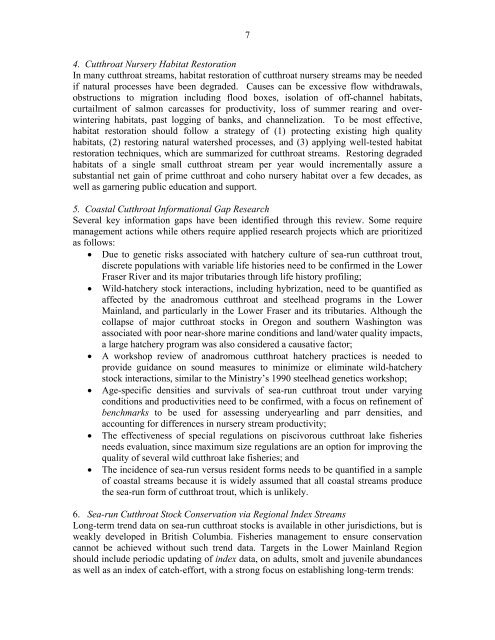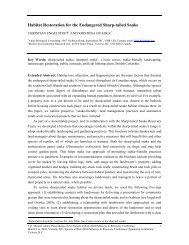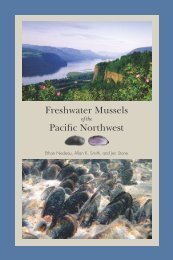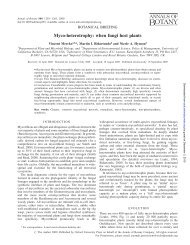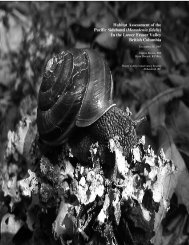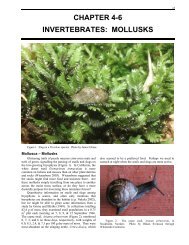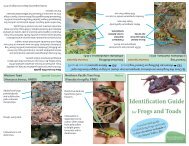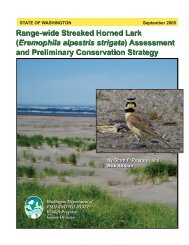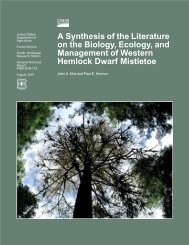Coastal Cutthroat Trout as Sentinels of Lower Mainland Watershed ...
Coastal Cutthroat Trout as Sentinels of Lower Mainland Watershed ...
Coastal Cutthroat Trout as Sentinels of Lower Mainland Watershed ...
You also want an ePaper? Increase the reach of your titles
YUMPU automatically turns print PDFs into web optimized ePapers that Google loves.
74. <strong>Cutthroat</strong> Nursery Habitat RestorationIn many cutthroat streams, habitat restoration <strong>of</strong> cutthroat nursery streams may be neededif natural processes have been degraded. Causes can be excessive flow withdrawals,obstructions to migration including flood boxes, isolation <strong>of</strong> <strong>of</strong>f-channel habitats,curtailment <strong>of</strong> salmon carc<strong>as</strong>ses for productivity, loss <strong>of</strong> summer rearing and overwinteringhabitats, p<strong>as</strong>t logging <strong>of</strong> banks, and channelization. To be most effective,habitat restoration should follow a strategy <strong>of</strong> (1) protecting existing high qualityhabitats, (2) restoring natural watershed processes, and (3) applying well-tested habitatrestoration techniques, which are summarized for cutthroat streams. Restoring degradedhabitats <strong>of</strong> a single small cutthroat stream per year would incrementally <strong>as</strong>sure <strong>as</strong>ubstantial net gain <strong>of</strong> prime cutthroat and coho nursery habitat over a few decades, <strong>as</strong>well <strong>as</strong> garnering public education and support.5. <strong>Co<strong>as</strong>tal</strong> <strong>Cutthroat</strong> Informational Gap ResearchSeveral key information gaps have been identified through this review. Some requiremanagement actions while others require applied research projects which are prioritized<strong>as</strong> follows:• Due to genetic risks <strong>as</strong>sociated with hatchery culture <strong>of</strong> sea-run cutthroat trout,discrete populations with variable life histories need to be confirmed in the <strong>Lower</strong>Fr<strong>as</strong>er River and its major tributaries through life history pr<strong>of</strong>iling;• Wild-hatchery stock interactions, including hybrization, need to be quantified <strong>as</strong>affected by the anadromous cutthroat and steelhead programs in the <strong>Lower</strong><strong>Mainland</strong>, and particularly in the <strong>Lower</strong> Fr<strong>as</strong>er and its tributaries. Although thecollapse <strong>of</strong> major cutthroat stocks in Oregon and southern W<strong>as</strong>hington w<strong>as</strong><strong>as</strong>sociated with poor near-shore marine conditions and land/water quality impacts,a large hatchery program w<strong>as</strong> also considered a causative factor;• A workshop review <strong>of</strong> anadromous cutthroat hatchery practices is needed toprovide guidance on sound me<strong>as</strong>ures to minimize or eliminate wild-hatcherystock interactions, similar to the Ministry’s 1990 steelhead genetics workshop;• Age-specific densities and survivals <strong>of</strong> sea-run cutthroat trout under varyingconditions and productivities need to be confirmed, with a focus on refinement <strong>of</strong>benchmarks to be used for <strong>as</strong>sessing underyearling and parr densities, andaccounting for differences in nursery stream productivity;• The effectiveness <strong>of</strong> special regulations on piscivorous cutthroat lake fisheriesneeds evaluation, since maximum size regulations are an option for improving thequality <strong>of</strong> several wild cutthroat lake fisheries; and• The incidence <strong>of</strong> sea-run versus resident forms needs to be quantified in a sample<strong>of</strong> co<strong>as</strong>tal streams because it is widely <strong>as</strong>sumed that all co<strong>as</strong>tal streams producethe sea-run form <strong>of</strong> cutthroat trout, which is unlikely.6. Sea-run <strong>Cutthroat</strong> Stock Conservation via Regional Index StreamsLong-term trend data on sea-run cutthroat stocks is available in other jurisdictions, but isweakly developed in British Columbia. Fisheries management to ensure conservationcannot be achieved without such trend data. Targets in the <strong>Lower</strong> <strong>Mainland</strong> Regionshould include periodic updating <strong>of</strong> index data, on adults, smolt and juvenile abundances<strong>as</strong> well <strong>as</strong> an index <strong>of</strong> catch-effort, with a strong focus on establishing long-term trends:


